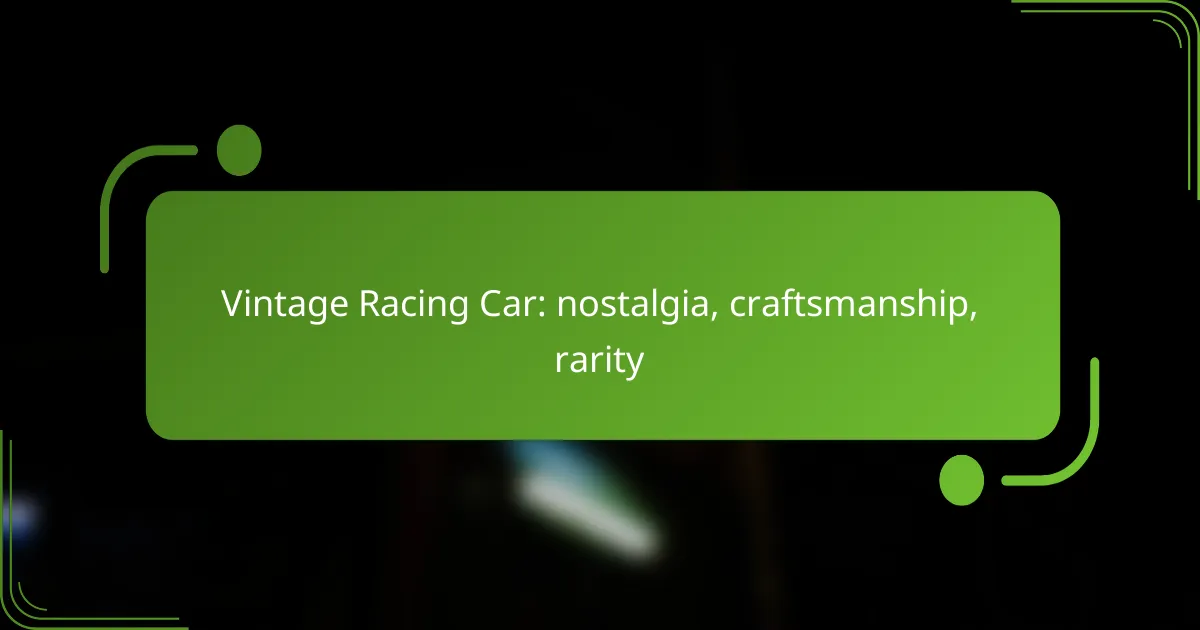Vintage racing cars embody a unique blend of nostalgia, craftsmanship, and rarity, captivating collectors and enthusiasts alike. With their classic designs and high-performance engines, these iconic vehicles not only represent a significant piece of automotive history but also serve as prized possessions in the racing world. Their limited production numbers further enhance their allure, making them highly sought after by those who appreciate the artistry and engineering behind each model.

What are the best vintage racing cars available in Canada?
The best vintage racing cars available in Canada include iconic models known for their craftsmanship, rarity, and historical significance. Collectors and enthusiasts often seek out these vehicles for their performance and nostalgic value, making them prized possessions in the automotive world.
Ford GT40
The Ford GT40 is a legendary racing car that gained fame in the 1960s for its dominance at the Le Mans 24-hour race. With a sleek design and powerful V8 engine, it was engineered for speed and performance, making it a favorite among vintage racing enthusiasts.
When considering a Ford GT40, look for models with original parts and a well-documented racing history, as these factors significantly enhance their value. Prices for authentic GT40s can range from hundreds of thousands to several million Canadian dollars, depending on condition and provenance.
Porsche 917
The Porsche 917 is another iconic vintage racing car, celebrated for its innovative design and remarkable speed. It played a crucial role in Porsche’s success in endurance racing during the late 1960s and early 1970s, often seen as a symbol of automotive excellence.
In Canada, the availability of Porsche 917s is limited, with only a few original models on the market. Collectors should prioritize cars with a verified racing background, as these tend to command higher prices, often reaching into the millions of Canadian dollars.
Ferrari 250 GTO
The Ferrari 250 GTO is widely regarded as one of the most desirable vintage racing cars in the world. Known for its stunning design and exceptional performance, the 250 GTO has become a benchmark for classic car collectors, often fetching record prices at auctions.
In Canada, finding a Ferrari 250 GTO can be a challenge due to its rarity. Potential buyers should be prepared for prices that can exceed several million Canadian dollars, reflecting its status as a collector’s item. Ensure any purchase is backed by thorough documentation and authenticity verification to safeguard your investment.

How to buy a vintage racing car in Canada?
Buying a vintage racing car in Canada involves thorough research, networking, and understanding the market. Focus on reputable sources, attend auctions, and connect with enthusiasts to find the right vehicle that fits your passion and budget.
Research reputable dealers
Start by identifying reputable dealers who specialize in vintage racing cars. Look for dealers with a solid track record and positive reviews from previous buyers. Websites, forums, and social media can provide insights into their credibility.
Consider visiting their showrooms to inspect the cars in person. A trustworthy dealer will be transparent about the car’s history, condition, and any restoration work done. Always ask for documentation to verify authenticity.
Attend vintage car auctions
Participating in vintage car auctions is an excellent way to find unique racing cars. Major cities in Canada often host auctions, where you can see a variety of models and potentially secure a great deal. Research upcoming events and register in advance to participate.
During the auction, set a budget and stick to it. Be prepared to act quickly, as bidding can be competitive. Familiarize yourself with the auction process and fees, which can include buyer’s premiums and taxes.
Join vintage racing clubs
Joining vintage racing clubs can enhance your buying experience by connecting you with fellow enthusiasts. These clubs often have access to exclusive sales, events, and resources that can help you find the right car.
Engage with club members to gain insights into the best models and potential sellers. Networking within these communities can lead to valuable recommendations and opportunities that may not be available through traditional channels.

What are the key features of vintage racing cars?
Vintage racing cars are distinguished by their classic design, high-performance engines, and limited production numbers. These features contribute to their nostalgia, craftsmanship, and rarity, making them highly sought after by collectors and enthusiasts alike.
Classic design elements
Classic design elements of vintage racing cars often include sleek lines, distinctive curves, and retro color schemes that evoke a sense of nostalgia. Many models feature unique bodywork, such as aluminum or fiberglass, which not only enhances aesthetics but also reduces weight for improved performance.
Additionally, vintage racing cars frequently showcase intricate craftsmanship, with hand-stitched leather interiors and polished wood accents. These details reflect the dedication to quality and artistry that characterized automotive design in earlier decades.
High-performance engines
High-performance engines are a hallmark of vintage racing cars, often featuring powerful configurations such as V8 or inline-six designs. These engines typically produce significant horsepower, enabling impressive acceleration and speed on the track.
Many vintage racing cars utilize carburetors instead of modern fuel injection systems, which can enhance the driving experience with a raw, mechanical feel. Enthusiasts often appreciate the sound and responsiveness of these engines, which contribute to the overall charm of vintage racing.
Limited production numbers
Limited production numbers significantly enhance the rarity and desirability of vintage racing cars. Many models were produced in small batches, often due to the high costs of materials and labor during their era. This scarcity makes finding specific models a challenge for collectors.
As a result, some vintage racing cars can fetch high prices at auctions, sometimes reaching hundreds of thousands or even millions of dollars. The combination of rarity and historical significance makes these vehicles not only a passion for enthusiasts but also a potential investment opportunity.

What is the nostalgia associated with vintage racing cars?
The nostalgia linked to vintage racing cars stems from their rich history, craftsmanship, and the emotions they evoke in enthusiasts and collectors. These vehicles represent a bygone era of motorsport, capturing the spirit of competition and innovation that defined their time.
Connection to motorsport history
Vintage racing cars serve as tangible links to the early days of motorsport, showcasing the evolution of automotive technology and design. Many of these cars participated in significant races, contributing to the development of racing as a professional sport.
For example, models like the Ford Model T and the Bugatti Type 35 not only dominated tracks but also influenced future automotive engineering. Collectors often seek these cars not just for their rarity but for their stories and the milestones they represent in racing history.
Iconic racing moments
Many vintage racing cars are associated with legendary moments that have become part of motorsport folklore. Events such as the Mille Miglia and Le Mans have seen remarkable performances that are still celebrated today.
Cars like the Ferrari 250 GTO and the Porsche 917 are remembered for their thrilling victories and dramatic rivalries, creating a sense of nostalgia for fans who recall these pivotal races. Such moments enhance the allure of owning a vintage racing car, as they embody the excitement and passion of the sport.
Influence on car culture
The impact of vintage racing cars extends beyond the racetrack, influencing car culture and automotive design. They inspire modern car manufacturers to blend classic aesthetics with contemporary technology, appealing to a wide range of enthusiasts.
Car shows, auctions, and vintage racing events celebrate this heritage, fostering a community that appreciates the craftsmanship and artistry of these vehicles. Collectors often find value not just in the cars themselves, but in the lifestyle and camaraderie that surround vintage racing culture.

What craftsmanship is involved in vintage racing cars?
Craftsmanship in vintage racing cars involves meticulous handwork and a deep understanding of automotive engineering. Each vehicle is often a unique creation, reflecting the skill and artistry of its builders, which contributes to its rarity and nostalgic appeal.
Hand-built components
Vintage racing cars are typically constructed with hand-built components, which enhances their uniqueness and performance. Parts such as the chassis, body panels, and engine components are often crafted from high-quality materials like aluminum or steel, tailored specifically for each model. This bespoke approach allows for greater customization and optimization for racing conditions.
For example, the use of lightweight materials can significantly improve speed and handling, while custom-engineered engines can provide the necessary power for competitive racing. The craftsmanship involved in creating these components ensures that each car not only performs well but also carries a distinct character.
Attention to detail
Attention to detail is paramount in the craftsmanship of vintage racing cars. Builders focus on every aspect, from the precision of the engine assembly to the finish of the paintwork. This level of detail not only affects the car’s aesthetics but also its performance and reliability on the track.
Common areas where detail is crucial include the alignment of suspension components, the tuning of the engine, and the quality of the upholstery. Small imperfections can lead to significant performance issues, making it essential for builders to adhere to high standards throughout the construction process. Collectors often seek out cars that exemplify this meticulous craftsmanship, as it adds to the vehicle’s value and historical significance.
